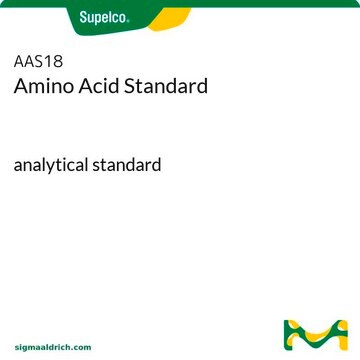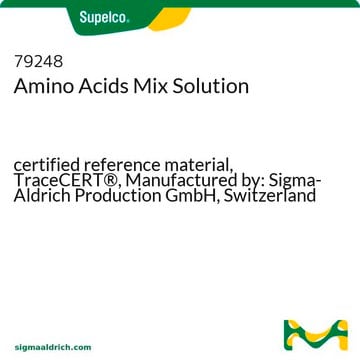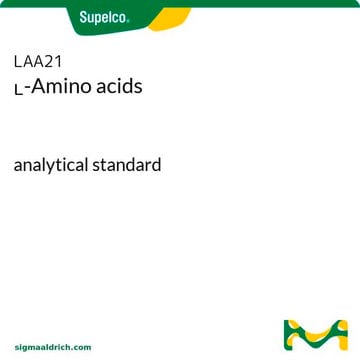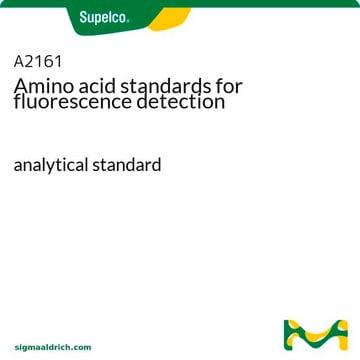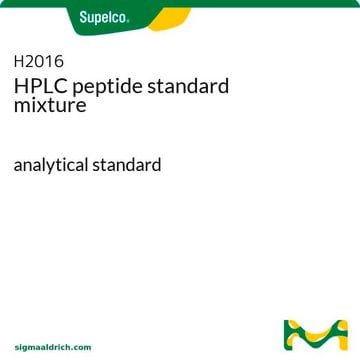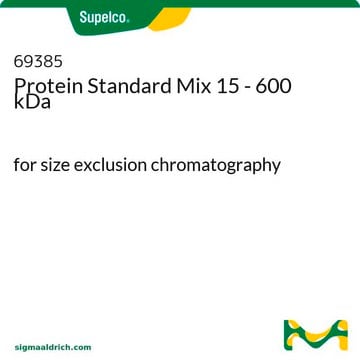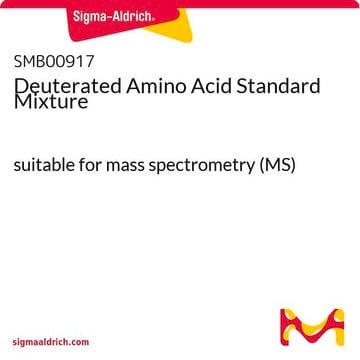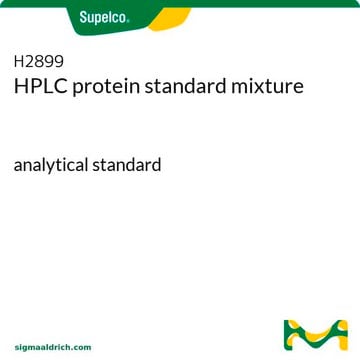Products may be shipped at a different temperature than the recommended long-term storage temperature. If the product quality is sensitive to short-term exposure to conditions other than the recommended long-term storage, it will be shipped on wet or dry-ice. If the product quality is NOT affected by short-term exposure to conditions other than the recommended long-term storage, it will be shipped at ambient temperature. As shipping routes are configured for minimum transit times, shipping at ambient temperature helps control shipping costs for our customers. For more information, please refer to the Storage and Transport Conditions document: https://www.sigmaaldrich.com/deepweb/assets/sigmaaldrich/marketing/global/documents/316/622/storage-transport-conditions-mk.pdf
A9781
Amino acid standards for protein hydrolysates
analytical standard
Seleccione un Tamaño
Seleccione un Tamaño
About This Item
Productos recomendados
grado
analytical standard
composición
L-Alanine
Ammonium chloride
L-Arginine
L-Aspartic acid
L-Cystine
L-Glutamic acid
Glycine
L-Histidine
L-Isoleucine
L-Leucine
L-Lysine
L-Methionine
L-Phenylalanine
L-Proline
L-Serine
L-Threonine
L-Tryosine
L-Tryptophan
L-Valine
clases químicas de analitos
amino acids, peptides, proteins
técnicas
HPLC: suitable
gas chromatography (GC): suitable
color
colorless
aplicaciones
food and beverages
Formato
neat
temp. de almacenamiento
2-8°C
Categorías relacionadas
Aplicación
Otras notas
Código de clase de almacenamiento
12 - Non Combustible Liquids
Clase de riesgo para el agua (WGK)
WGK 3
Punto de inflamabilidad (°F)
Not applicable
Punto de inflamabilidad (°C)
Not applicable
Elija entre una de las versiones más recientes:
Certificados de análisis (COA)
¿No ve la versión correcta?
Si necesita una versión concreta, puede buscar un certificado específico por el número de lote.
¿Ya tiene este producto?
Encuentre la documentación para los productos que ha comprado recientemente en la Biblioteca de documentos.
Los clientes también vieron
-
How is shipping temperature determined? And how is it related to the product storage temperature?
1 answer-
Helpful?
-
-
How can I determine the shelf life / expiration / retest date of this product?
1 answer-
If this product has an expiration or retest date, it will be shown on the Certificate of Analysis (COA, CofA). If there is no retest or expiration date listed on the product's COA, we do not have suitable stability data to determine a shelf life. For these products, the only date on the COA will be the release date; a retest, expiration, or use-by-date will not be displayed.
For all products, we recommend handling per defined conditions as printed in our product literature and website product descriptions. We recommend that products should be routinely inspected by customers to ensure they perform as expected.
For products without retest or expiration dates, our standard warranty of 1 year from the date of shipment is applicable.
For more information, please refer to the Product Dating Information document: https://www.sigmaaldrich.com/deepweb/assets/sigmaaldrich/marketing/global/documents/449/386/product-dating-information-mk.pdfHelpful?
-
-
Good afternoon. I am searching for a mixture of aminoacids to built method in HPLC to identify several amino acids. I need to know their concentration in the mixture to construct a calibration curve. Will this the best option? thanks
1 answer-
Amino Acids Mix Solution - 79248-5X2ML is suitable for this application. The COA can be found here, https://www.sigmaaldrich.com/certificates/Graphics/COfAInfo/fluka/pdf/PDF746486.pdf.
Helpful?
-
-
A9781 is it suitable for PDA detector HPLC
1 answer-
Product A9781-5ML is suitable for HPLC analysis. While the analysis of amino acids using a PDA/UV requires a lot of steps, it is still possible and practical. However, most HPLC methods for amino acid quantification uses Mass Spectrometry (MS) or Charged Aerosol Detector (CAD) detectors.
Helpful?
-
Active Filters
Nuestro equipo de científicos tiene experiencia en todas las áreas de investigación: Ciencias de la vida, Ciencia de los materiales, Síntesis química, Cromatografía, Analítica y muchas otras.
Póngase en contacto con el Servicio técnico